In December 2006, Brenda and I once again set out for Asheville, NC to see my folks for the holidays and to see her brother and his family in Frisco, TX. You can follow Brenda's detailed account of our trip to find out all about the non-aviation-related fun we had and to see more pictures. This is my pilot's-eye view of the trip.
More than out previous long trips, this one seemed to have a lot more times where I had to make safety-related decisions. That may be just because the weather was more active this year, or I may have just noticed more. The actual flying was really smooth, but we spent some time sitting that I hadn't planned on.
Brenda took a bunch of pictures, some of which I put into an album. The thumbnails for each leg are taken from that album and are links to the medium-sized pictures.
Day 1
Santa Monica, CA (SMO) to Mesa, AZ (FFZ)
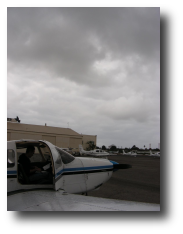 We started the trip out with a weather decision, but an easy one. There
was
a storm system trucking down the coast for Southern California, and the
edges of it were licking at the LA basin. Truth to be told, most of the
basin had a thin layer over it, and it wasn't exactly warm.
Flight service didn't report any icing and
with the bases at 4000' or so I had plenty of room to stay below them
and turn around if things get hairy, so off we went
(IFR of course).
We started the trip out with a weather decision, but an easy one. There
was
a storm system trucking down the coast for Southern California, and the
edges of it were licking at the LA basin. Truth to be told, most of the
basin had a thin layer over it, and it wasn't exactly warm.
Flight service didn't report any icing and
with the bases at 4000' or so I had plenty of room to stay below them
and turn around if things get hairy, so off we went
(IFR of course).
We didn't spend much time in the clouds at all. We climbed through a scattered layer to go over LAX. Brenda commented that it looks like a whole different airport with the clouds framing it. Most of the familiar sights look different in the glimpsed between clouds.
It was a fairly quiet morning – quiet enough that a controller asked if we were getting out before the storm – and we only had a few minutes of IMC out near Seal Beach before we were on top in the sunshine. No ice in the clouds, though it was fairly turbulent.
The turbulence near Seal beach was a herald of more up and down drafts as we crossed the mountains that border the basin to the west, near Palm Springs. These are big mountains, to the tune of 8000+'. The winds blowing over them created some pretty strong drafts as we crossed over them. At one point I was knocked down almost 200' prompting a controller to ask what was up. I report the drafts and tell him I can manage terrain clearance, though the drafts may cause some deviations. We were never off enough for a pilot deviation or any danger and he passed the pilot report on to flight service.
The turbulence was pretty much the last tricky part of this leg, and Brenda slept through that. We got slightly rerouted and were given a more direct course to FFZ, and there was a 25 knot or so tailwind component helping us out. We passed south of the high desert I enjoy so much, but it was still an enjoyable flight out.
We grab lunch at FFZ and also pick up some aspirin for Brenda's headache.
Mesa, AZ (FFZ) to El Paso, TX (ELP)
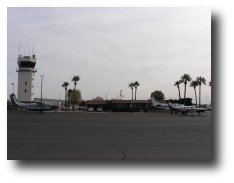 Off to El Paso, our planned stop for the night. We were
IFR again both to make the transition out of
the Phoenix Class B easier and because I
expected to be in the dark when we got to El Paso. The route from Santa
Monica to El Paso crosses 2 time zones, so we were planning to stop even
if it was light in order to avoid all the restaurants and hotels closing
up on us.
Off to El Paso, our planned stop for the night. We were
IFR again both to make the transition out of
the Phoenix Class B easier and because I
expected to be in the dark when we got to El Paso. The route from Santa
Monica to El Paso crosses 2 time zones, so we were planning to stop even
if it was light in order to avoid all the restaurants and hotels closing
up on us.
This was the point in the route where we doglegged south to avoid a bunch of restricted airspace in New Mexico. As a result, we ran somewhat afoul of the wind blowing from the southwest, and the initial almost due southerly route that ATC assigns us was a slow crawl. Still fighting her headache, Brenda went out like a light.
The southward crawl's only real high point was hearing a two UK pilots check on in identical aircraft going to the identical small airport. I don't know if there was some sort of Liverpool pilots' fly-in scheduled (and they weren't saying), but it was fairly comical hearing the controller try to keep them straight. It didn't help that they were both in a marginal area of radio coverage.
Man, there's not a whole lot between the Phoenix area and El Paso. There were mountains and the scenery wasn't exactly boring, but when spotting a pumping station that's noted on the sectional is cause for a little celebration, you know it's not the most interesting part of the trip.
The most interesting part of the flight was probably the landing. We arrived after dark and were vectored for a visual approach to El Paso's 26 right runway. Despite being on a pretty major airport, I quickly found that there wasn't a whole lot of lighting around the runway beyond the standard edge lights. There also wasn't any visual glideslope indicator of any kind. Landing at night on this kind of isolated runway can lead to a black hole illusion, which can cause a pilot to fly an excessively low approach or even stall. We didn't get a good picture of the runway at night, but we did get one during the day. Hopefully you can see how there are few visual cues.
Now, I know what that illusion is, and I'm perfectly capable of grappling with it, but there was a well lighted runway with a visual glideslope and favorable winds right next door. I could hear Southwest jets on the radio using it. I broke off my approach and requested and got the more favorable runway. As I say, there were a lot of safety-first moments on this trip.
Day 2
El Paso, TX (ELP) to Midland, TX (MAF)
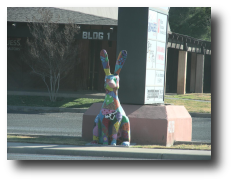 Boy did I have trouble getting out of El Paso. The airborne parts were
all pretty easy, but I had the worst time finding the actual runway. I
got lost twice, even after getting a
progressive taxi.
Boy did I have trouble getting out of El Paso. The airborne parts were
all pretty easy, but I had the worst time finding the actual runway. I
got lost twice, even after getting a
progressive taxi.
Once in the air, all went pretty well. We were IFR, honestly because I didn't want the president sneaking up on us. Midland bills itself as George W.'s home town, so I figured he might show up there. (GWB's ranch is south of Dallas, and is prominently displayed on the Dallas sectional, but better safe than sorry.)
The IFR routing wasn't significantly different than the direct VFR route anyway, so it was easy enough to take. The leg was one of the few completely routine ones. Not much to do but look at the amazing Guadalupe Mountains and keep the fuel tanks balanced. The stiff tailwind meant we didn't have to do that for long.
Again, the landing was the fun part, with a pretty stiff crosswind blowing. It wasn't my most beautiful crosswind landing, but certainly nothing awful. Apparently Texas has nothing but crosswinds; it seems that once one starts there's nothing between El Paso and Dallas to get in its way.
This was a lunch stop for us and we confused and were confused by the locals in Odessa.
Midland, TX (MAF) to McKinney, TX (TKI)
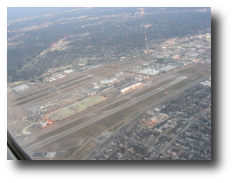 McKinney Regional is actually named “Collin County Regional
Airport at McKinney,” in the tradition of the Los
Angeles Angels of Anaheim. I learned from flight
service that the locals call it “McKinney.” Those guys
are great for everything. I discovered this while filing our IFR flight plan to McKinney. It would be night
when we got there and IFR handling would simplify getting through the
busy DFW airspace.
McKinney Regional is actually named “Collin County Regional
Airport at McKinney,” in the tradition of the Los
Angeles Angels of Anaheim. I learned from flight
service that the locals call it “McKinney.” Those guys
are great for everything. I discovered this while filing our IFR flight plan to McKinney. It would be night
when we got there and IFR handling would simplify getting through the
busy DFW airspace.
They did change up the arrival procedure into the DFW area, but I'd already pulled both plates in case they did. Again, the trip itself was fairly routine. The desolation of west Texas gives way to farmland and lakes as you get closer to Dallas. The sun was setting, but it was mostly dusk by the time we got to Dallas.
The vectors to McKinney included a fair amount of visual navigation, which was fine as we had great VMC the whole way. By the time we were vectored to McKinney itself we were following a combination of a lighted highway and the GPS. (Well, technically, we were following the GPS and using the lighted highway as a cue to find the airport.)
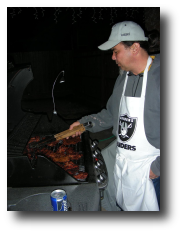 We were cleared for a visual
approach and the tower controller basically tried to squeeze us in
before a Seminole (which is a twin-engine aircraft; I don't know the pilot's
nationality) that wanted to do a series of touch and goes. So
basically this meant I needed to do a short approach and get out of the
Seminole's
way or he'd have to go around. It was
going to be tight to get us both on the ground, but basically not a
safety risk. We could both see each other and understood the game. At
worst the Seminole would fly another trip in the pattern, so I gave it a
shot. I wasn't quite fast enough, or the controller squeezed us too
close. Either way we didn't quite get both down, and the Seminole went
around.
We were cleared for a visual
approach and the tower controller basically tried to squeeze us in
before a Seminole (which is a twin-engine aircraft; I don't know the pilot's
nationality) that wanted to do a series of touch and goes. So
basically this meant I needed to do a short approach and get out of the
Seminole's
way or he'd have to go around. It was
going to be tight to get us both on the ground, but basically not a
safety risk. We could both see each other and understood the game. At
worst the Seminole would fly another trip in the pattern, so I gave it a
shot. I wasn't quite fast enough, or the controller squeezed us too
close. Either way we didn't quite get both down, and the Seminole went
around.
We arrived at the FBO, Cutter Aviation, just as their holiday party was starting. Everyone was still professional and helpful, but I was happy when Brenda's brother showed up to take us back to the Podemski ranch for a week of vacation.
Day 3
McKinney, TX (TKI)
to
Oxford, MS (UOX)
Tupelo, MS (TUP)
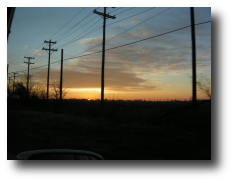 One of the things I like about these long cross country trips is the
opportunity to stop at a lot of different airports. When we're far from
home, I tend to aim for major metropolitan areas and towered airports.
They're more likely to have sizable FBOs that
are open later hours and be able to deal with mechanical or other
problems. The places we've stopped have certainly helped us many times.
Still, I like to get a smaller field or two into the mix when I can.
One of the things I like about these long cross country trips is the
opportunity to stop at a lot of different airports. When we're far from
home, I tend to aim for major metropolitan areas and towered airports.
They're more likely to have sizable FBOs that
are open later hours and be able to deal with mechanical or other
problems. The places we've stopped have certainly helped us many times.
Still, I like to get a smaller field or two into the mix when I can.
The first leg between McKinney and Asheville was a good place to try for a small, uncontrolled field. It would be a daytime landing and a short stopover on the way to Asheville, a couple days before Christmas itself, so things should be open and a nice chance to take in the local atmosphere. Oxford it was!
First we had an early drive out to McKinney. It was just cold enough to have some frost on the wings, but there was enough sun to melt it. It turns out that though watching frost melt is a lot like watching paint dry, when the temperature is close to freezing, it's a little more exciting. Basically after a long pre-flight, we were ready to go.
Ready that is except for getting the engine started. It was cold enough, and the plane had sat long enough that it was pretty sluggish starting it up. And I somewhat under-primed it because I wasn't so used to the cold. We did get it fired up and were off to Oxford, VFR.
The trip itself was clear and pleasant. We have been this way before and it was fun to pick out some of places we've been, like Texarkana Airport, and to see some new places, like Bill Clinton's home town of Hope. Crossing the Mississippi River is always fun for me, and crossing it here gave a chance to see the whorls and loops that the lower Mississippi takes across the flatlands. It's easy to see why Twain said that even for experienced steamboat pilots every trip was different. The zero isogonic line was in here, too, but I missed noting when we crossed it.
I'd had a little too much morning tea and water en route, so I was really happy to see Oxford when I did. We made an uneventful landing and taxied over to the terminal. And it was closed. No fuel, no terminal, but – whew – open clean restrooms. And “no fuel” is an exaggeration; there was a callout fee for fuel. Still, a NOTAM would have been nice.
Now, if I'd been betting the farm on fuel at Oxford, I would have just paid the callout fee and gotten some fuel. Fortunately, I knew Oxford was small and uncontrolled and therefore things happened. I'd already had a backup plan to continue on to Tupelo, MS – birthplace of Elvis – in case of just such a development.
The flight out to Tupelo was straightforward and short. We landed with more than an hour of reserve, and tooled on over to Tupelo Aero for fuel and food. If you get a chance, the pilot lounge at Tupelo Aero is really quite impressive.
Tupelo, MS (TUP) to Asheville, NC (AVL)
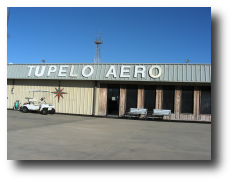 Man they like to move you right out when you're
IFR out of Tupelo. We were IFR because we'd
be getting to Asheville after dark, though it was clear and cloud-free
along our whole route. Still, passing me my clearance on the taxiway to
the single runway as a commercial carrier is also queueing up with no
way around me put some pressure on.
Man they like to move you right out when you're
IFR out of Tupelo. We were IFR because we'd
be getting to Asheville after dark, though it was clear and cloud-free
along our whole route. Still, passing me my clearance on the taxiway to
the single runway as a commercial carrier is also queueing up with no
way around me put some pressure on.
To be clear: it was solid VMC and I knew my filed route and was ready to fly it. The changes that he read me were small enough that the whole thing represented a welcome challenge not a dangerous workload swamping. It was an interesting challenge, though. Had to be ready to fly the local stuff and get the amendments programmed into the GPS pretty much on the fly. Interesting departure.
The departure was probably the most interesting part of the flight from a technical perspective. It is an interesting part of the world to fly over with more forested areas and small farms with small towns to mid-sized cities dotting the route. There are a ton more visual references and checkpoints than in West Texas, that's for sure.
We did get to relay a message to an aircraft that was out of touch with ATC along this leg. It's a simple thing, but it's always nice to be a help.
The approach and landing into Asheville were straightforward. We got a visual approach landing north which worked very will with out route. We settled in at Million Air and waited for my parents to settle us in for Christmas.
We had a great week or so visiting with my parents and sister, meeting folks, doing Christmas things and just hanging out. It was a great time as always.
Day 4
Asheville, NC (AVL) to Huntsville, AL (HSV)
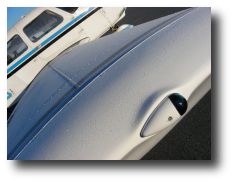 Traveling east to west by small plane in winter is always harder than
west to east. Coming east, you can often nestle into a high pressure
system between storm systems and just follow it across the country. You
usually have tailwinds, or at least only moderate headwinds. Coming
back both those are stacked against you. As a result, the trip back to
McKinney took two legs instead of one, and though we were hoping to let
the storm pass over us overnight,
like our last
winter trip, the possibility of an extra day in McKinney was also
there.
Traveling east to west by small plane in winter is always harder than
west to east. Coming east, you can often nestle into a high pressure
system between storm systems and just follow it across the country. You
usually have tailwinds, or at least only moderate headwinds. Coming
back both those are stacked against you. As a result, the trip back to
McKinney took two legs instead of one, and though we were hoping to let
the storm pass over us overnight,
like our last
winter trip, the possibility of an extra day in McKinney was also
there.
First we had to get out of Asheville, where the wings had frosted up nicely, and unlike McKinney, the ambient temperature was below freezing. The good folks at Million Air hauled 32169 into a heated hangar to melt off the ice, but as I brought it back into the cold, the water just re-froze, so I wound up getting de-iced anyway. They were very patient and professional about it, and very accommodating when I asked for the precautionary de-ice though they were getting ready to deal with a couple other quick turns. They were really exemplary professionals.
The VFR flight out to Huntsville was really pretty straightforward. There was a significant headwind, for sure. We were basically bucking 15-20 knots of wind the whole way, which wasn't fun at all.
As we arrived, a Boeing 737 was settling in on the other runway for a couple touch and goes. Impressive.
The folks at the Huntsville FBO were also great, getting us turned around quickly and happily.
Huntsville, AL (HSV) to Little Rock, AR (LIT)
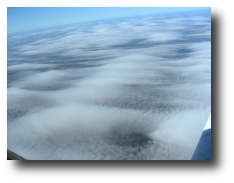 We had some cloud cover forecast for Little Rock, and I'm usually of the
opinion that it's easier to cancel IFR if
things get better than to try to get a clearance if things get worse.
We were able to get an IFR clearance to Little Rock without any trouble
and got on our way.
We had some cloud cover forecast for Little Rock, and I'm usually of the
opinion that it's easier to cancel IFR if
things get better than to try to get a clearance if things get worse.
We were able to get an IFR clearance to Little Rock without any trouble
and got on our way.
Fairly early on we got over enough of an undercast to make any pilotage pretty useless. The instruments were our primary source of navigation, though we were in VMC above them pretty much the whole time.
The undercast was pretty interesting, looking like little lenticular clouds. You often see those kind of clouds when wind is blowing hard over ridge lines, though there aren't a lot of ridges in this area. I think that the rippled effects came from the difference in wind speeds between the two layers. Above the clouds, winds were stiff, and from the west, and they seemed less so down low.
It was annoying to see the groundspeed as low as it was, but with the shorter legs, we really didn't have any safety concerns. After a brief descent through clouds into the Little Rock area, we again got a visual approach. The visual took us over a pretty impressive trainyard.
We got fueled up at the Central Flying Service. Despite their spiffy web page and dot aero DNS domain, they were a nice homey outfit in a huge, beautiful hangar complex. Their café serves the self-proclaimed “Greatest Cheeseburger in the History of Aviation.” It's actually quite good.
Little Rock, AR (LIT) to McKinney, TX (TKI)
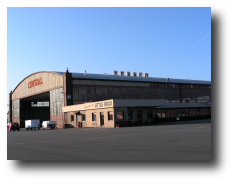 The overcast from our last leg was going to stay with us on the next
one, but there was no indication of storms or ice, so all was well to
get back to McKinney and the Podemski Ranch.
The overcast from our last leg was going to stay with us on the next
one, but there was no indication of storms or ice, so all was well to
get back to McKinney and the Podemski Ranch.
We had a bunch of wind, though. We lost easily 15-20 knots of groundspeed, but a fair amount of that was in adjusting for drift rather then direct headwind. We were holding 20 degrees of wind correction. Again, because of the short legs, this was annoying rather than risky.
As partial compensation for the crawl across Arkansas and Texas, the sunset and evening clouds were really beautiful. Sunsets above the clouds are always a treat for me, but the layers made these spectacular just in terms of their geometry. Impressive shadows from higher layers as the sun also made mini-sunsets behind the upper layers and things like that. The play of light was difficult to capture, so you really had to be there.
As we arrived in the Dallas area, we let down through a couple thousand feet of undercast and began hunting for McKinney. We were still holding a big enough wind correction angle that even when tracking directly to the airport, the beacon was 20 or 25 degrees to the right of the nose.
As we got lower, the wind changed direction, but kept up its velocity. It was Texas of course, so a 15 knot crosswind component was mandatory. Night crosswind landings are good for the soul, I suppose. I've had to hold crosswind corrections this big in the desert, but it's always impressive to do so. The landing was uneventful.
It was pretty clear that the front wasn't going to come over us tonight, so we planned to stay a day with the Podemskis and get out the day after. That's how it worked out, though as the front passed through it made its presence known pretty strongly. The weather was severe enough that the local stations interrupted their afternoon and evening programs to track the storms through the metro area. Several tornadoes touched down, though thankfully none near us. A good day to be in the ground.
Day 5
McKinney, TX (TKI) to Midland, TX (MAF)
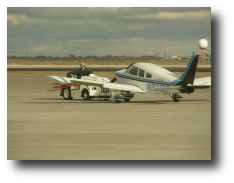 Our extra day in Texas had allowed the front causing all the storms to
pass us to the east, though the low pressure system that the fronts
were circling around was taking it's sweet time getting out of the area.
Still weather looked good to the west and set off for Midland, TX once
we'd cleared another day's frost from the plane. We were
IFR to simplify crossing the
DFW
Class B airspace.
Our extra day in Texas had allowed the front causing all the storms to
pass us to the east, though the low pressure system that the fronts
were circling around was taking it's sweet time getting out of the area.
Still weather looked good to the west and set off for Midland, TX once
we'd cleared another day's frost from the plane. We were
IFR to simplify crossing the
DFW
Class B airspace.
The Midland leg was a short one because I was anticipating a headwind, but man did we get more than I bargained for. Leaving the DFW area, winds were stiff, but believable, dragging our airspeed down 10-15 knots into the mid 90's. The further west we got, the worse they got, and by the time we were nearing Midland, the GPS was indicating groundspeeds in the high 70 knot range for significant periods.
The winds take a toll in that as we flew further west, the land became less green and returned to the desolate West Texas norms. Comparatively zipping out of the fairly green Dallas area into a slog across the flatter, drier, more desolate spaces is somewhat disheartening.
The stiff the winds were expected and we reached Midland with plenty of reserve fuel and had several options along the way for early stops. We reached Midland with plenty of time to grab some food locally and head off to finish the night in El Paso, as planned.
It looked that way until I looked at the weather after we'd eaten. That slow moving low pressure system hadn't left us alone after all and the northwest side of it had spawned a snowstorm that was licking south toward El Paso. Specifically, an icing AIRMET had popped up between Midland and El Paso.
I wrestled a bit with my get-there-itis here. I really wanted to get to El Paso, and we'd lost a day to weather already. But there are AIRMETs and there are AIRMETs. The first icing AIRMET you take lightly can be your last. I poked around at current conditions to make sure it was a believable icing AIRMET, but sure enough there were supporting PIREPs and prognosis and satellite images supported it. And then there were those winds, which could stretch fuel thin (and supported the notion that a weather system of consequence was in the area). And finally there was little to nothing in the way of alternate airports reachable in case of widespread icing conditions.
Man, I wanted to go, but all those conditions added up to a seriously unflyable situation in the aircraft I had. So we called for a hotel in town and settled in for the night.
Now, usually when I make one of these no-go weather decisions I set it in stone in my mind and then hope I was right. And fret about whether or not I've been a wimp about it. (Go decisions are pretty much always up for discussion, though.) This time I was lucky enough to talk with another pilot who'd tried to fly the same route in a Bonanza while I was unsuccessfully trying to wish the weather reports away; he'd had to turn back because of ice. It was nice to go to sleep that night with confidence that I'd made a good decision, and it helps make future good decisions as well.
Brenda's blogged about the Eleganté, and I feel like I should say that the place was actually pretty good. It clearly has changed hands recently and they're spinning up a new staff, which is causing some start-up pains. I think that as they fill in their staff, which they probably have now, it will be an excellent place to stay.
I also wish that the graphics for AIRMETs looked more like Brenda's version
Day 6
Midland, TX (MAF) to El Paso, TX (ELP)
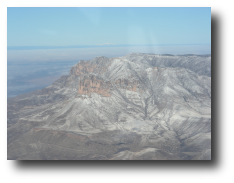 As it usually is when you weather over, the next day's weather was
largely beautiful. The single place it wasn't was
El Paso International
itself, which was reporting an indeterminate ceiling in freezing fog.
It was sparkling clear everywhere else, though, and unlike the situation
with widespread icing conditions, the shortness of the leg left
many alternates, including several between Midland and El Paso. Even
better, the El Paso forecast called for clearing before we arrived. I
put in an IFR flight plan.
As it usually is when you weather over, the next day's weather was
largely beautiful. The single place it wasn't was
El Paso International
itself, which was reporting an indeterminate ceiling in freezing fog.
It was sparkling clear everywhere else, though, and unlike the situation
with widespread icing conditions, the shortness of the leg left
many alternates, including several between Midland and El Paso. Even
better, the El Paso forecast called for clearing before we arrived. I
put in an IFR flight plan.
We were slowed down for another half hour waiting for the sun to clear the frost from our wings as well. I didn't mind the wait as it brought El Paso closer to clearing. Shortly we were off.
And the good news kept coming: the headwinds, though present and stiff, were not slowing us down to anywhere near 70 knots groundspeed. We made a steady 95-100 knots across the ground which fattened up that safety margin and set of alternates nicely.
As we passed our halfway point, we did have a discussion with the controller about the conditions at El Paso, and another with flight service. The consensus was that conditions were still lousy at El Paso itself, but were improving as predicted (El Paso issued an improving weather observation as I was talking to the flight service briefer). All the alternates were still completely clear as well, so we pressed on.
Brenda was napping for a fair part of this leg, but I woke her up to see the snow that previous night's storm dropped on the Guadalupe Mountains. The mountains themselves are starkly impressive, and the snow highlighted their topography. It was almost worth staying over in Midland to see them dusted. (That's them in the thumbnail for this hop.)
The arrival in El Paso was really a visual one, though the official observation was still bad enough that they cleared us for the GPS approach rather than a visual. We never saw a cloud and landed in solid VMC. Conditions were basically improving so fast that the observations weren't keeping up.
This was a quick turn for us, as we were basically hoping to make it home with the help of two time zone crossings. So we gassed up and got ready for the next hop.
El Paso, TX (ELP) to Goodyear, AZ (GYR)
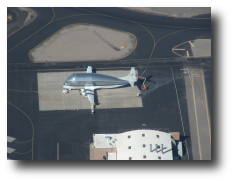 With the weather clear pretty much the whole way, this was a
VFR leg out to
Phoenix Goodyear Airport.
With the weather clear pretty much the whole way, this was a
VFR leg out to
Phoenix Goodyear Airport.
Departure was straightforward and we were off to Arizona. (Brenda got the great shot of the Super Guppy that's in the thumbnail on departure.) There was a lot of desert until we got closer to Cochise, AZ (though we actually turned northward near San Simon), where we got into some mountainous territory.
About midway between Demming, NM and San Simon, AZ, ATC informed us that we had traffic directly behind us that was overtaking us. The traffic apparently had us in sight as it moved to pass us on the right, and as it came around we saw it as well. The other pilot apparently wasn't getting advisories.
In and of itself, this is no big deal. The other aircraft was passing us slowly on the right, as is correct for the right of way rules. As we were closing in on San Simon VOR, the other plane had almost pulled close enough that I estimated we'd be abeam each other close to the VOR. Now, I knew I was turning right at San Simon, and if the other aircraft either turned left or kept straight, we might have to maneuver a to avoid each other. So I slowed down to about 80 knots and increased spacing. I was happy I did when the other plane turned left at San Simon. We had each other in sight, so I don't think that there would have been any conflict in the turns, but I feel better to have avoided even the possibility.
Other than avoiding some parachute jumping near Phoenix, and getting an unsolicited clearance through the Phoenix Class B the rest of the leg was pretty uneventful.
Phoenix Goodyear is quite an airport. The kind of odd name arises from the fact that the airport is in Goodyear, AZ, but run by the city of Phoenix. And they run it well; everyone was friendly and helpful, and the airport has the cleanest flight line I've ever seen. Good stop if you're in the Phoenix area.
Goodyear, AZ (GYR) to Santa Monica, CA (SMO)
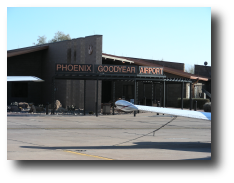 This was the last leg of the trip, and all indications were that it was
to be a simple VFR trip into familiar
airspace. Even with the help of the timezone shifts, we expected to
arrive after dark, but given the familiar airspace and forecast
conditions, I decided to do it VFR.
This was the last leg of the trip, and all indications were that it was
to be a simple VFR trip into familiar
airspace. Even with the help of the timezone shifts, we expected to
arrive after dark, but given the familiar airspace and forecast
conditions, I decided to do it VFR.
Headwinds stiffened up a little this leg, but other than making me a little sad that the last leg wasn't just flying by, this didn't affect much. We were still well within acceptable groundspeeds.
As we got closer to the LA Basin, I heard another aircraft pick up an IFR clearance into Santa Monica. That's usually a good time to check on the conditions with flight service. It turns out that Santa Monica was reporting a ceiling, so we picked up an IFR clearance ourselves. The clearance pretty much matched the route I was planning, anyway, so this wasn't a big inconvenience.
The reported weather was low enough that we needed an approach into SMO, but as is often the case, the descent path of the approach took us into the airport without having to encounter any clouds. The clouds in question were an advancing marine layer.
There's always one more thing, of course, and in this case it was a landing light that had burned out in flight. Santa Monica's well lighted and I was comfortable making the landing with the light out, but it was aggravating at the last minute. Fortunately, I'd received a relatively high-power flashlight for Christmas that was strong enough to taxi by.
Another excellent trip punctuated by visits with friends and family as well as an interesting and challenging flying experience.